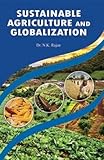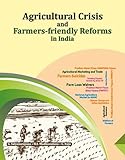 |
Learning Resource Centre Monthly Bulletin |
 |
 |
Learning Resource Centre Monthly Bulletin |
 |
| New Books |
 B108064 Handbook of Agriculture By ICAR |  B108180 Agriculture Bio-Integrated Farming Systems By Roy, K P |  B108184 Sustainable Agriculture and Globalization By Rajan, N K |  B108270 Agricultural Crisis and Farmers-friendly Reforms i By Satyanarayana, G |
| Click Here to learn about the Recent Books added to our collection on different topics of Management. |
| Articles |
| The digital revolution in India: bridging the gap in rural technology adoption By Sindakis, Stavros; Showkat, Gazal. Journal of Innovation and Entrepreneurship; Heidelberg Vol. 13, Iss. 1, (Dec 2024): 29. DOI:10.1186/s13731-024-00380-w Abstract :This study investigates the factors that influence the adoption of digital technology in rural areas of India, with a focus on the Digital India Program (DIP). By analyzing the age distribution, education levels, technology adoption rates, and utilization patterns among rural populations, this research provides insights into the effectiveness of the DIP in targeting specific demographics and promoting digital inclusion. Quantitative data were collected from 400 respondents in Kalahandi District in the Odisha state of India. The data collected were analyzed using SPSS. The findings reveal a predominantly young population in rural India, indicating a workforce with significant economic potential and a higher likelihood of embracing digital technologies. Moreover, the study highlights the high levels of education among respondents, indicating a population well-equipped to understand and benefit from digital initiatives. Unexpectedly, the research shows a higher rate of digital technology adoption among female respondents, challenging the perception of gender disparities in technology access. This finding suggests that the DIP has played a vital role in bridging the gender gap and empowering women in rural areas. Additionally, the study uncovers a trend towards mobile-based services over computer-based services, signaling a shift in technology utilization patterns. This emphasizes the need to prioritize mobile technology and improve connectivity in rural areas to ensure wider access to digital platforms. | |||
| Factors Influencing the Adoption of FinTech for the Enhancement of Financial Inclusion in Rural India Using a Mixed Methods Approach By Jena, Rabindra Kumar Journal of Risk and Financial Management; Basel Vol. 18, Iss. 3, (2025): 150. DOI:10.3390/jrfm18030150 Abstract :The swift expansion of financial technology (FinTech) can substantially improve financial inclusion, especially in the rural regions of emerging nations such as India. FinTech has the potential to drive inclusive growth, reduce inequalities, and foster sustainable economic development. This research examines the determinants affecting the adoption of FinTech services in rural India by synthesizing three theoretical frameworks: The Technology Acceptance Model (TAM), the Theory of Planned Behavior (TPB), and the Technology Readiness Index (TRI). A mixed methods approach that combines partial least squares structured equation modeling (PLS-SEM) and fuzzy set comparative qualitative analysis (fsQCA) was used to evaluate the suggested framework. The integrated PLS-SEM and fsQCA offer a comprehensive, elegant, and resilient method for data analysis. While fsQCA addresses more intricate patterns within the data, PLS-SEM effectively identifies the relationships among significant factors. This makes the mixed method approach more judicious and advantageous than the single method approach. The findings showed that attitude (β = 0.35), perceived behavioral control (β = 0.28) from the Theory of Planned Behavior (TPB), perceived ease of use (β = 0.31) from the Technology Acceptance Model (TAM), and perceived insecurity (β = −0.19) from the Technology Readiness Index (TRI) all have a big impact on how people use FinTech. The findings also indicate that the desire to adopt FinTech positively influences financial inclusion among rural residents. These research findings enhance the debate on sustainable development by demonstrating how specific FinTech interventions can close the financial inclusion gap, empower rural populations, and achieve various Sustainable Development Goals (SDGs). The study’s findings could help governments, banks, and FinTech firms aiming to enhance the accessibility and use of digital financial services in rural India. | |||
| Evaluating the impact of advertising strategies on rural brand building: Insights from the personal care FMCG sector By Sharma, Vinod; Maheshkar, Chandan; Mahajan, Yogesh; Remsei, Sándor; Kapse, Manohar Innovative Marketing; Sumy Vol. 21, Iss. 3, (2025): 117-127. DOI:10.21511/im.21(3).2025.09 Abstract :This study examines how advertising strategies, namely, content, media, and design, influence brand-building efforts in rural markets, with a specific focus on the mediating role of content relevance. Anchored in the Elaboration Likelihood Model (ELM), the research recognizes that rural consumers often process advertising through the peripheral route, relying on visual, linguistic, and cultural cues rather than rational evaluation. Data were collected through a structured survey of 498 rural consumers across thirteen towns in Madhya Pradesh. Using covariance-based structural equation modelling, the study finds that advertising content (β = 0.353), media (β = 0.253), and design (β = 0.298) significantly affect brand perceptions. More importantly, content relevance emerges as a key mediator, with indirect effects ranging from β = 0.180 to 0.243 (p < 0.01), indicating that rural consumers are more likely to engage with advertising that aligns with their values, language, and lifestyle. Theoretically, the study extends the ELM framework to low-involvement consumer settings and highlights the nuanced role of cultural relevance in shaping brand engagement. Practically, the findings offer marketers a roadmap for creating locally adapted and emotionally resonant campaigns that move beyond urban-centric models. This research underscores the importance of designing inclusive advertising strategies that build lasting brand relationships with India’s diverse rural population. | |||
| Do you wish to explore more articles? Just try using one of the full-text databases below! | |||
| Faculty - Click here to recommend new topics in Rural |
| News |
| Rural unemployment down, urban joblessness up, finds government survey By The Hindu; Nov 11 2025 |
| Seasonal fall in demand for work under rural jobs scheme much sharper Jun-Oct this year By Mint; Nov 9 2025 |
Wish to see more News? Click the link below: |